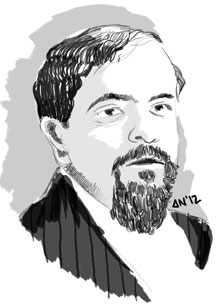Debussy: Between Impressionism and Symbolism by Emmanuelle Piedboeuf
/ September 1, 2012
Version française...
Flash version here.
 If you ask a music lover which composer has had the strongest influence on classical music in the 20th century, chances are the names of Stravinsky or Schoenberg would be mentioned. While this would not be wrong, it is important to remember the composer who has facilitated the stylistic freedom that has enabled composers to write differently: Claude Debussy. This year we are celebrating the 150th anniversary of the composer’s birth (August 22, 2012).
If you ask a music lover which composer has had the strongest influence on classical music in the 20th century, chances are the names of Stravinsky or Schoenberg would be mentioned. While this would not be wrong, it is important to remember the composer who has facilitated the stylistic freedom that has enabled composers to write differently: Claude Debussy. This year we are celebrating the 150th anniversary of the composer’s birth (August 22, 2012).
Debussy first gained recognition after he was awarded the prestigious Prix de Rome in 1884. Along with the award came a three-year stay at the Villa Medici, during which he was required to send a work to the Conseil des Arts to be performed. After two years, he submitted Le Printemps, which was refused by the Académie’s Secretary in a letter warning him about “impressionism, the most dangerous enemy of artistic truth.” It is this label that branded him as an impressionist for all of Europe, something he fought against his entire life. After he left the Villa, Debussy spent a lot of time with symbolist writers, including Mallarmé and Pierre Loüys, with whom he shared many ideals. François de Médicis, PhD and musicology professor at the Université de Montréal believes that “although early on the collective imagination associated Debussy with musical impressionism [and] he belongs to this movement by virtue of its themes, […] he adhered more to symbolism than impressionism.”
Transcending both impressionism and symbolism, Debussy’s musical language marked the era of modernity from “his constant concern with originality [and from] the fact he was always looking forward.” But this originality was far from being unintentional since, having studied at the Conservatoire, the composer relied on techniques of the old masters, pushing these techniques to their limits or rejecting them altogether. He used pentatonicism, whole tone scales and unresolved dissonances by taking them out of the tonal framework and suspending “the tonal music factor”. Having traveled to Russia in his youth, Debussy showed “an affinity with non-European music.” These trips are probably what prepared him for the Paris Exposition Universelle of 1889, where he discovered the Japanese gamelan and Annamite theatre. By integrating these elements into his language, he created a sound that was previously unknown, aligning himself in both “the circle of influence of the Russian tradition” and the line of Wagner, sparking something new: modernism.
After the Exposition Universelle, Debussy wrote Prélude à l’après-midi d’un faune and Pelléas et Mélisande, two works inspired by symbolist texts that helped him make his name throughout Europe. He then decided to undertake a more personal work, La mer, “[having] always [harboured] a deep love” for it. Subtitled as Esquisses symphoniques and adopting a three-movement form, the work did not receive the same kind of success as that of Pelléas, partly due to a bad performance at the premiere in 1905. He was even advised to play only the second movement, something he firmly refused. Success came eventually and the work was acclaimed for its tremendous maturity. Recognized for its brilliant tone and for how fleshed-out it is with regards to melody in comparison with works from his youth, La mer now regularly appears in the programs of symphony orchestras.
Like many other composers, Debussy was rarely satisfied with his own work. But he had high expectations for the performers he chose for his works and he was highly critical of every detail. During rehearsals for La mer, he explained this to the conductor by saying “[that he] did not feel music the same way every day.” De Médicis explains that contrary to earlier music, “Debussy’s music does not have strict boundaries;” it requires simultaneously “a strong presence of the performer [and] being sensitive to acoustics.” Performers can still rely on the extremely specific notes Debussy often left in the scores to have an idea of what he had in mind. But it still does not prevent differences in interpretation, the best advice coming from Debussy with respect to “feeling” music “[since] music does not need […] to make people think.”
Despite the fact that he spent his entire life trying to disassociate himself from Impressionist painters, it is probably this description that contributed to his popularity. Is it not more interesting to listen to an impression of the sea painted in musical notes than a simple melody devoid of expression?
Debussy’s La mer and Pelléas et Mélisande directed by Jacques Lacombe with the OSM on September 13 and 14.
www.osm.ca
Translation: John Delva
Version française... |
|


